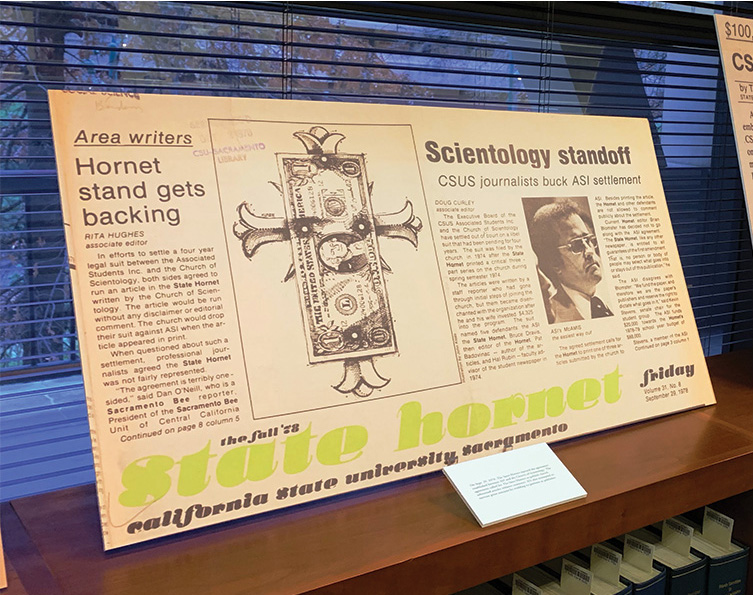Until Next Time
State Hornet has fought some battles in 70 years – here’s mine
Brian Blomster
"Things got heated. One student senator threatened to stomp me, and we were told that violating a court order could land me in jail."

A State Hornet retrospective display includes the Sept. 29, 1978, front, with coverage that brought a contentious confrontation between the publication and the Church of Scientology to a head – and then resolution. Photo by Andrea Price
About 40 years ago, I stepped into the middle of a battle between the State Hornet newspaper, of which I was editor, and the Church of Scientology, which was royally ticked off.
A few years before I was named editor, in 1974, the Hornet published articles harshly critical of Scientology. The author was a member of the newspaper staff and had written his stories based on his experiences joining the organization. He felt ripped off, and in so many words, he said so, while characterizing Scientology in dark terms.
Scientology’s reaction was to sue, and eventually an out-of-court settlement was reached – backed by a court order – between Scientology and Sac State student government, Associated Students Inc. (ASI).
Skip ahead to September 1978, when the deal was made known to me, then an enthusiastic, barely qualified new leader of the State Hornet. My predecessor as editor, Doug Curley ‘78 (Journalism), was familiar with the agreement and laid it out for me: The Hornet was to publish on its front page – without headline, introduction, or identification of any kind – a Scientology tract containing whatever that organization wanted to include; and the Hornet would not publish any editorial or news content that referred to the Scientology piece. We were to run their propaganda and keep still about it.
That, of course, was not going to happen. I might have been a little green, but I knew prior restraint and violation of the First Amendment when I saw (and smelled) it.
Members of my editorial staff and I met several times with ASI representatives. Our position was that student government had no right to cut a deal involving the newspaper. ASI argued that they had every right since they provided some funding ($20,000) for the Hornet’s operation, even though that funding represented a relatively small part (23 percent) of our operating budget ($88,000). They claimed that they were, in fact, the newspaper’s publisher.
Things got heated. One student senator threatened to stomp me, and we were told that violating a court order could land me in jail.
But we stood on principle. Leading up to the Friday when we were to run the Scientology tract, members of the Hornet staff worked on a media blitz. This was decades before social media, so we used traditional avenues of communications: We went to the Sacramento Bee and the Union, took our story to television and radio stations, and generated support from working journalists.
So on what was our D-Day, instead of several thousand words from the Church of Scientology, what appeared in the Sept. 29 edition of the State Hornet were stories about the deal, about why we were rejecting it, and why we had legal and journalistic support.
We also published an editorial decrying the deal, and commentary from Professor Hal Rubin, Hornet faculty advisor when the original Scientology series ran.
Reaction was swift and predictable. ASI was furious. The local Scientology chapter was up in arms. Acting Dean of Students Timothy F. Comstock was disappointed, not necessarily by what we did, but because he was blindsided – something I regretted because he was very supportive of the Hornet and of me personally.
We received the press coverage we wanted, and all the noise forced a reassessment of the issue. Curley and I had a subsequent meeting with Scientology representatives, explained our position and heard them out. Basically, they were tired of the whole thing and dropped the matter, knowing that the perceived assault on the student press was a losing gambit.
I was persona non grata with ASI, or at least with some of the senators, and when I went before them to ask for funding for the following year, well, they provided the requested financial support despite my presence, not because of it.
Why the old newspaper war story? I hadn’t given much thought to it for a long time, at least until plans for the State Hornet’s 70th anniversary cranked up in earnest. Representatives of the current editorial staff asked me about my time as editor and, specifically, about the Scientology issue.
It was then that I was reminded of the significant role the student press has on campus. Moreover, I was proud to lead a staff that provided support throughout the conflict, and how reporters, editors, photographers, designers, and advertising staff stood arm-in-arm in defense of principles, most of which we were learning at Sac State.
Were we right? I think so; plenty of people felt otherwise. But I know this: Sac State gave us the room and the opportunity to choose our path. And it gave us the practical and intellectual training to base our choices on something more than guesswork.
Congratulations, State Hornet, on reaching this significant milestone. Stingers Up.
Brian Blomster is News and Communications director for Sac State and editor-in-chief of Sac State Magazine. He can be reached at brian.blomster@csus.edu and (916) 278-3835.